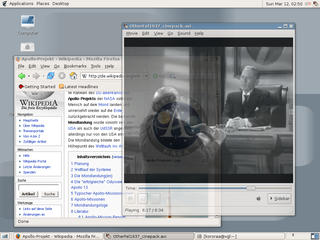QuickTime is a discontinued extensible multimedia architecture created by Apple, which supports playing, streaming, encoding, and transcoding a variety of digital media formats. The term QuickTime also refers to the QuickTime Player front-end media player application, which is built-into macOS, and was available for download on Windows until 2016.

The Graphics Device Interface (GDI) is a legacy component of Microsoft Windows responsible for representing graphical objects and transmitting them to output devices such as monitors and printers. It was superseded by Direct2D API. Windows apps use Windows API to interact with GDI, for such tasks as drawing lines and curves, rendering fonts, and handling palettes. The Windows USER subsystem uses GDI to render such UI elements as window frames and menus. Other systems have components that are similar to GDI; for example: macOS has Quartz, and Linux and Unix have X Window System and Wayland.
QuickDraw is the 2D graphics library and associated Application Programming Interface (API) which is a core part of the classic Mac OS operating system. It was initially written by Bill Atkinson and Andy Hertzfeld. QuickDraw still existed as part of the libraries of Mac OS X, but had been largely superseded by the more modern Quartz graphics system. In Mac OS X v10.4, QuickDraw has been officially deprecated. In Mac OS X v10.5 applications using QuickDraw cannot make use of the added 64-bit support. In Mac OS X v10.8, QuickDraw header support was removed from the operating system. Applications using QuickDraw will still run under OS X 10.8 through macOS 10.13; however, the current versions of Xcode and the macOS SDK do not contain the header files to compile such programs.
Quartz 2D is the native two-dimensional graphics rendering API for macOS and iOS platforms, part of the Core Graphics framework.
Core Image is a pixel-accurate, near-realtime, non-destructive image processing technology in Mac OS X. Implemented as part of the QuartzCore framework of Mac OS X 10.4 and later, Core Image provides a plugin-based architecture for applying filters and effects within the Quartz graphics rendering layer. The framework was later added to iOS in iOS 5.
Quartz Compositor is the display server in macOS. It is responsible for presenting and maintaining rasterized, rendered graphics from the rest of the Core Graphics framework and other renderers in the Quartz technologies family.
In Apple's macOS operating system, Quartz is the Quartz 2D and Quartz Compositor part of the Core Graphics framework. Quartz includes both a 2D renderer in Core Graphics and the composition engine that sends instructions to the graphics card. Because of this vertical nature, Quartz is often synonymous with Core Graphics.

Cairo is an open-source graphics library that provides a vector graphics-based, device-independent API for software developers. It provides primitives for two-dimensional drawing across a number of different back ends. Cairo uses hardware acceleration when available.

The Direct Rendering Infrastructure (DRI) is the framework comprising the modern Linux graphics stack which allows unprivileged user-space programs to issue commands to graphics hardware without conflicting with other programs. The main use of DRI is to provide hardware acceleration for the Mesa implementation of OpenGL. DRI has also been adapted to provide OpenGL acceleration on a framebuffer console without a display server running.

Real-time computer graphics or real-time rendering is the sub-field of computer graphics focused on producing and analyzing images in real time. The term can refer to anything from rendering an application's graphical user interface (GUI) to real-time image analysis, but is most often used in reference to interactive 3D computer graphics, typically using a graphics processing unit (GPU). One example of this concept is a video game that rapidly renders changing 3D environments to produce an illusion of motion.

Xgl is an obsolete display server implementation supporting the X Window System protocol designed to take advantage of modern graphics cards via their OpenGL drivers, layered on top of OpenGL. It supports hardware acceleration of all X, OpenGL and XVideo applications and graphical effects by a compositing window manager such as Compiz or Beryl. The project was started by David Reveman of Novell and first released on January 2, 2006. It was removed from the X.org server in favor of AIGLX on June 12, 2008.
In computing, hardware overlay, a type of video overlay, provides a method of rendering an image to a display screen with a dedicated memory buffer inside computer video hardware. The technique aims to improve the display of a fast-moving video image — such as a computer game, a DVD, or the signal from a TV card. Most video cards manufactured since about 1998 and most media players support hardware overlay.

Quartz Composer is a node-based visual programming language provided as part of the Xcode development environment in macOS for processing and rendering graphical data.
The Intel Graphics Media Accelerator (GMA) is a series of integrated graphics processors introduced in 2004 by Intel, replacing the earlier Intel Extreme Graphics series and being succeeded by the Intel HD and Iris Graphics series.

The ATI Rage is a series of graphics chipsets developed by ATI Technologies offering graphical user interface (GUI) 2D acceleration, video acceleration, and 3D acceleration developed by ATI Technologies. It is the successor to the ATI Mach series of 2D accelerators.
Core OpenGL, or CGL, is Apple Inc.'s Macintosh Quartz windowing system interface to the OS X implementation of the OpenGL specification. CGL is analogous to GLX, which is the X11 interface to OpenGL, as well as WGL, which is the Microsoft Windows interface to OpenGL.
The Apple Developer Tools are a suite of software tools from Apple to aid in making software dynamic titles for the macOS and iOS platforms. The developer tools were formerly included on macOS install media, but are now exclusively distributed over the Internet. As of macOS 10.12, Xcode is available as a free download from the Mac App Store.
VirtualGL is an open-source software package that redirects the 3D rendering commands from Unix and Linux OpenGL applications to 3D accelerator hardware in a dedicated server and sends the rendered output to a (thin) client located elsewhere on the network. On the server side, VirtualGL consists of a library that handles the redirection and a wrapper program that instructs applications to use this library. Clients can connect to the server either using a remote X11 connection or using an X11 proxy such as a VNC server. In case of an X11 connection some client-side VirtualGL software is also needed to receive the rendered graphics output separately from the X11 stream. In case of a VNC connection no specific client-side software is needed other than the VNC client itself.
Core Animation is an animation graphics compositing framework used by macOS, iOS, watchOS, and tvOS to produce animated user interfaces.
The term post-processing is used in the video/film business for quality-improvement image processing methods used in video playback devices, such as stand-alone DVD-Video players; video playing software; and transcoding software. It is also commonly used in real-time 3D rendering to add additional effects.






